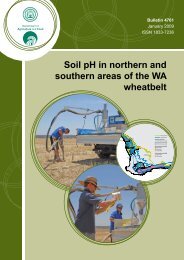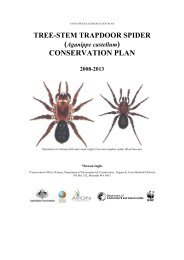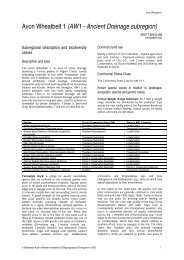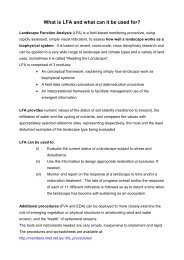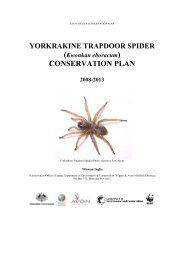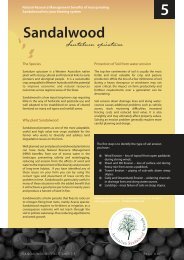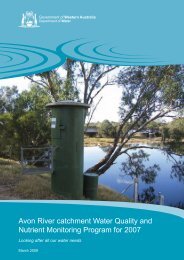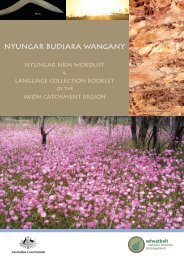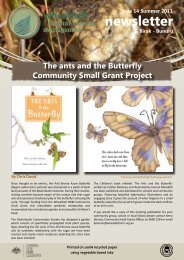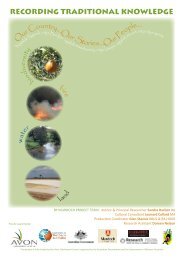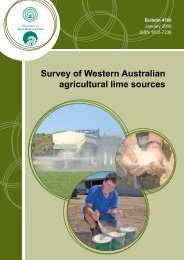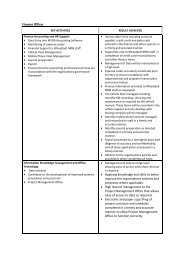Kokerbin Nature Reserve Desktop Fauna ... - Wheatbelt NRM
Kokerbin Nature Reserve Desktop Fauna ... - Wheatbelt NRM
Kokerbin Nature Reserve Desktop Fauna ... - Wheatbelt NRM
Create successful ePaper yourself
Turn your PDF publications into a flip-book with our unique Google optimized e-Paper software.
<strong>Kokerbin</strong> <strong>Nature</strong> <strong>Reserve</strong><br />
<strong>Desktop</strong> <strong>Fauna</strong> Assessment<br />
5.2.2 Birds<br />
Malleefowl (Leipoa ocellata)<br />
EPBC VULNERABLE<br />
The Malleefowl is listed as Vulnerable under the EPBC and Wildlife Conservation<br />
Acts. In Western Australia Malleefowl occur mainly in scrubs and thickets of Mallee<br />
(Eucalyptus spp.), Boree (Melaleuca lanceolata) and Bowgada (Acacia linophylla),<br />
and also other dense litter-forming shrublands including Mulga (Acacia aneura)<br />
Shrublands (Johnstone and Storr, 2004). The species distribution was once larger and<br />
less fragmented, but the widespread clearing of suitable habitat, coupled with the<br />
degradation of habitat by fire and livestock, and fox predation has reduced Malleefowl<br />
numbers considerably.<br />
The Malleefowl previously inhabited a large part of arid inland Western Australia<br />
however has undergone a dramatic range reduction in the region. Malleefowl are<br />
unlikely to occur at <strong>Kokerbin</strong> <strong>Nature</strong> <strong>Reserve</strong>.<br />
Fork-tailed Swift (Apus pacificus) EPBC MIGRATORY<br />
The Fork-tailed Swift is listed as Migratory under the EPBC Act and under Schedule<br />
3 of the Wildlife Conservation Act. The Fork-tailed Swift is an aerial species largely<br />
independent of terrestrial habitats. It has been recorded from the region however is<br />
likely to occur at <strong>Kokerbin</strong> <strong>Nature</strong> <strong>Reserve</strong> only as a rare visitor.<br />
Rainbow Bee-eater (Merops ornatus) EPBC MIGRATORY<br />
The Rainbow Bee-eater is listed as Migratory under the EPBC Act and under<br />
Schedule 3 of the Wildlife Conservation Act. This species inhabits open woodland,<br />
open forest, grasslands and arid woodlands especially along watercourses. During the<br />
breeding season, the Rainbow Bee-eater requires an open, sandy area to construct its<br />
nesting tunnel (Morcombe, 2000), such as creek banks or grasslands.<br />
The Rainbow Bee-eater has been recorded at <strong>Kokerbin</strong> <strong>Nature</strong> <strong>Reserve</strong>. The Rainbow<br />
Bee-eater is likely to be a spring/summer breeding visitor to the project area (Birds<br />
Australia, 2009), and may even construct its nesting burrows in disturbed soil along<br />
roadsides. It is a widespread species.<br />
MIGRATORY WADERS / WATERBIRDS<br />
EPBC MIGRATORY<br />
Common Greenshank (Tringa nebularia)<br />
Marsh Sandpiper (Tringa stagnatalis)<br />
Wood Sandpiper (Tringa glareola)<br />
Common Sandpiper (Tringa hypoleucos)<br />
The above species have been recorded from the region however due to a lack of<br />
suitable habitat are unlikely to occur at <strong>Kokerbin</strong> <strong>Nature</strong> <strong>Reserve</strong>.<br />
36



